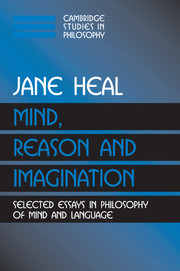Book contents
- Frontmatter
- Contents
- Preface
- Sources
- Mind, Reason and Imagination
- 1 Introduction
- PART I MIND, THEORY AND IMAGINATION
- PART II THOUGHT AND REASON
- PART III INDEXICAL PREDICATES AND THEIR APPLICATIONS
- 9 Indexical Predicates and Their Uses
- 10 On Speaking Thus: The Semantics of Indirect Discourse
- 11 Lagadonian Kinds and Psychological Concepts
- PART IV THINKING OF MINDS AND INTERACTING WITH PERSONS
- References
- Index
10 - On Speaking Thus: The Semantics of Indirect Discourse
Published online by Cambridge University Press: 18 December 2009
- Frontmatter
- Contents
- Preface
- Sources
- Mind, Reason and Imagination
- 1 Introduction
- PART I MIND, THEORY AND IMAGINATION
- PART II THOUGHT AND REASON
- PART III INDEXICAL PREDICATES AND THEIR APPLICATIONS
- 9 Indexical Predicates and Their Uses
- 10 On Speaking Thus: The Semantics of Indirect Discourse
- 11 Lagadonian Kinds and Psychological Concepts
- PART IV THINKING OF MINDS AND INTERACTING WITH PERSONS
- References
- Index
Summary
INTRODUCTION
This essay applies to the elucidation of indirect discourse an idea which has already been defended elsewhere: that of indexical predication (see Essay 9). The resulting view has, I suggest, the advantages of Davidson's proposal in “On Saying That” without its disadvantages (Davidson 1984: essay 7, first published 1968). Indeed, if Davidson had revised this earlier proposal about indirect speech in the light of the ideas sketched in “Quotation”, the upshot would resemble what is suggested here (Davidson 1984: essay 6, first published 1979; Rumfitt 1993: 431–432). Davidson's earlier proposal is that the ‘that’ of indirect discourse refers indexically to the particular utterance which follows it. The alternative view to be defended here is that a that-clause refers indexically to some non-particular item of which the particular utterance is an instance.
The essay, however, does not focus on the nature and identity conditions of these non-particulars or on the project of providing some formal theory of indirect discourse, although it offers just a little on these topics in the final section. Rather, as the title suggests, the aim is to approach the study of reports of speech through the idea of indexical predication and thereby to situate indirect discourse in a wider context. Doing so brings out motivations for the general view which would still be operative even if some particular implementation is found unacceptable.
Section 2 summarises the main relevant ideas about indexical predication.
- Type
- Chapter
- Information
- Mind, Reason and ImaginationSelected Essays in Philosophy of Mind and Language, pp. 174 - 195Publisher: Cambridge University PressPrint publication year: 2003



